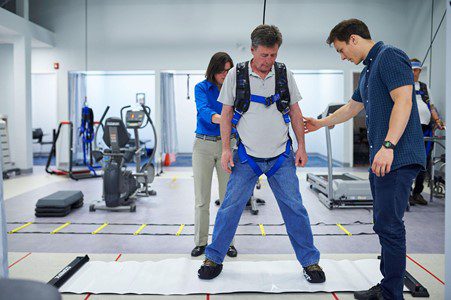Solo-Step: Gait Training 101

The Importance of Gait Training with Solo-Step
You recently may have had trouble staying balanced while walking, or you may have recently had an injury that impacted your ability to walk without feeling pain. Whatever it may be, your doctor may have recommended physical therapy or gait training to help you get back on your feet. The Solo-Step overhead track and harness system was made for any individual who may need a little assistance in gaining balance and improving their gait efficiently and effectively.
What is Balance and Gait Training?
Gait training primarily focuses on improving your ability to walk. It involves a combination of supervised walking on a treadmill, sometimes with a harness for support, and a series of exercises that help improve mobility and strength. These activities may include:
- Stepping over objects
- Lifting your legs
- Sitting down
- Standing up
And more
What Causes an Abnormal Gait?
There are numerous possibilities that may cause an abnormal gait, including but not limited to:
- Degenerative diseases (such as Arthritis)
- Inner ear disorders
- Stroke
- Foot conditions
- Neurologic conditions
- Something as simple as the wrong size of shoes
Types of Gait Disorders
- Propulsive Gait: Type of gait seen in patients with parkinsonism. It is characterized by a stooping, rigid posture, and the head and neck are bent forward. Steps tend to become faster and shorter.
- Scissors Gait: This type of gait gets its name because the knees and thighs hit or cross in a scissor-like pattern when walking. A patient’s legs, hips, and pelvis become flexed, making the person appear as though he or she is crouching. Steps are slow and small. This type of gait occurs often in patients with spastic cerebral palsy.
- Spastic Gait: Common to patients with cerebral palsy or multiple sclerosis, spastic gait is a way of walking in which one leg is stiff and drags in a semicircular motion on the side most affected by long-term muscle contraction.
- Steppage Gait: A “high stepping” gait in which the leg is lifted high, the foot drops (appearing floppy), and the toes point downward, scraping the ground when walking. Peroneal muscle atrophy or peroneal nerve injury, as with a spinal problem (such as spinal stenosis or herniated disc), can cause this type of gait.
- Waddling Gait: Movement of the trunk is exaggerated to produce a waddling, duck-like walk. Progressive muscular dystrophy or hip dislocation present from birth can produce a waddling gait.
Can Gait be Corrected?
If an underlying condition is the cause of an abnormal gait, a person’s walk should correct itself when the condition is treated. Some conditions or injuries may require surgery or physical therapy to help return the gait to normal.
Benefits of Gait Training
Gait training improves your ability to walk, stand and even run by including activities that strengthen your muscles and joints, improve posture, retrain legs for repetitive motion, balance, and muscle memory. Consistent gait training can be very effective in improving your day-to-day life and ability to do everyday tasks.

Who Is At Risk for a Gait Disorder?
Chances of a gait disorder increase with age, as older people tend to experience more conditions that cause an abnormal gait and typically have weaker muscles, delayed reaction, and less muscle coordination than younger people.
Solo-Step is a Safe and Effective Way to Recover From an Injury or Treat a Gait Disorder!
Over 600 physical therapy/nursing home facilities across the United States trust the Solo-Step safety overhead system to help patients gain confidence and strength while walking. Our ceiling-mounted track and harness system will allow you to focus on your therapy without the possibility of falling, so you can recover sooner and feel more confident.
